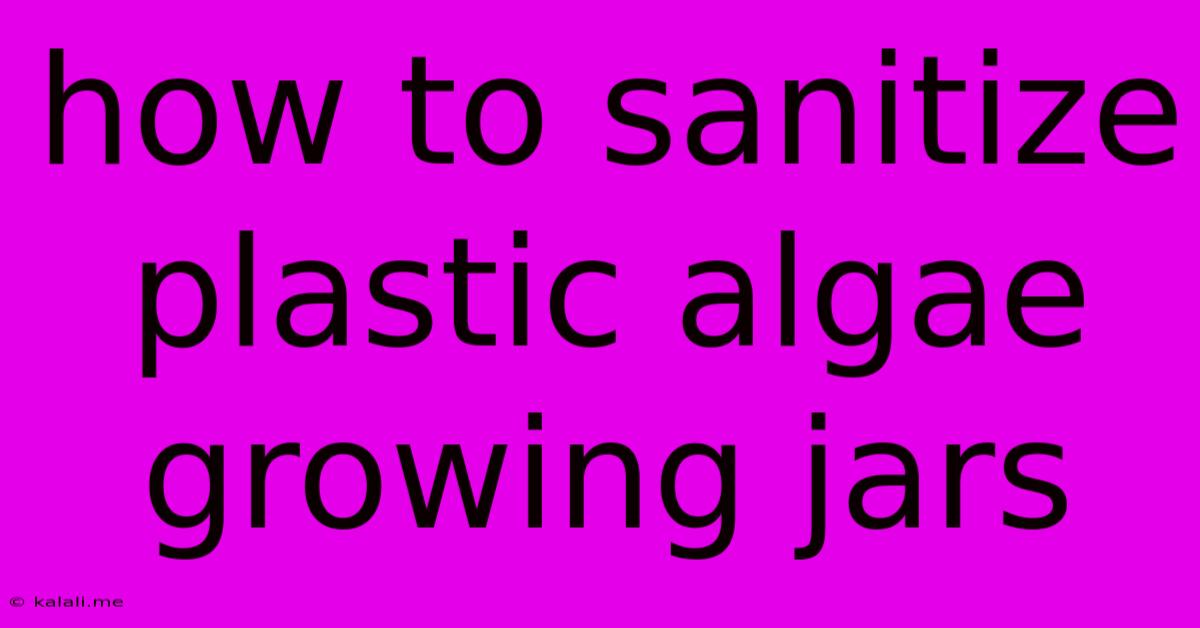How To Sanitize Plastic Algae Growing Jars
Kalali
Jun 06, 2025 · 3 min read

Table of Contents
How to Sanitize Plastic Algae Growing Jars: A Comprehensive Guide
Maintaining a clean and sterile environment is crucial for successful algae cultivation. Contamination can severely impact your algae growth, leading to reduced yields and potential loss of your cultures. This guide provides a comprehensive approach to sanitizing your plastic algae growing jars, ensuring optimal conditions for your algae to thrive. Knowing how to properly clean and sterilize these jars is key for preventing bacterial or fungal contamination and maximizing your algae production.
Why Sanitize Your Algae Growing Jars?
Before diving into the methods, let's understand why sanitizing your plastic algae growing jars is so important. Contamination from bacteria, fungi, or other microorganisms can compete with your algae for nutrients, slowing down growth or even killing your cultures. A contaminated jar can also produce unwanted byproducts, affecting the quality of your algae harvest. Regular sanitization ensures a healthy and productive algae cultivation process. This is especially important when working with different algae species or when reusing jars.
Choosing the Right Sanitization Method
The best method for sanitizing your plastic algae growing jars depends on the level of contamination and the type of plastic used. Always check the manufacturer's recommendations for your specific plastic jars to avoid damage. Some plastics may be damaged by certain chemicals.
Here are several effective methods:
1. Washing with Soap and Water: The First Line of Defense
This is the initial step in any sanitization process. Thoroughly wash your jars with warm water and a mild detergent, ensuring you remove all visible algae residue, debris, and any organic matter. Use a brush or sponge to reach all areas, including the neck and lid. Rinse thoroughly with clean water several times to remove all traces of soap. This physical cleaning is fundamental before moving to chemical sanitization.
2. Bleach Solution: A Powerful Disinfectant
A diluted bleach solution is a very effective disinfectant for killing many types of microorganisms. Mix a solution of 10% bleach (household bleach) and 90% water. Submerge your washed jars completely in the solution for at least 10-15 minutes. Afterward, thoroughly rinse the jars with sterile water multiple times to remove all traces of bleach. Important: Always wear gloves and eye protection when handling bleach. Proper ventilation is also crucial. Bleach is corrosive and can damage some plastics, so be sure your containers are bleach-compatible.
3. Autoclaving: The Gold Standard for Sterilization
Autoclaving is the most effective method for sterilization, using high-pressure steam to eliminate all microorganisms. This method is ideal for achieving complete sterility. However, it requires specialized equipment and isn't always accessible. This is often the best option for research and industrial settings. Ensure your plastic jars are autoclave-compatible before attempting this method.
4. Ethanol or Isopropyl Alcohol: A Quick and Convenient Option
For a quicker sanitization, you can use 70% ethanol or isopropyl alcohol. Spray the inside and outside of your washed jars and allow them to air dry completely. This method is effective against many bacteria and fungi, but it may not be as effective as bleach or autoclaving. Alcohol is highly flammable, so ensure adequate ventilation and keep away from open flames.
5. Hydrogen Peroxide: A Versatile Sanitizer
Hydrogen peroxide is another effective sanitizer that can be used as a spray or soak. The concentration will vary depending on the level of sanitation needed. Similar to alcohol, it’s vital to allow sufficient air drying.
Maintaining Cleanliness: Preventing Future Contamination
Once sanitized, it's crucial to maintain a clean environment for your algae cultures. This includes regularly cleaning your workspace, using sterile tools and equipment, and employing aseptic techniques throughout your handling process. Preventing contamination is much easier than curing it.
Conclusion
Sanitizing your plastic algae growing jars is a crucial step in ensuring successful algae cultivation. Choosing the appropriate method depends on several factors. By following these steps and practicing good laboratory practices, you can maintain a sterile environment and maximize your algae production. Remember to always prioritize safety and follow the instructions for any chemicals used.
Latest Posts
Latest Posts
-
How To Remove Bit From Dewalt Drill
Jun 07, 2025
-
How Long Is Tuna Good For In The Refrigerator
Jun 07, 2025
-
How To Cook Mushrooms For Pizza
Jun 07, 2025
-
Cube Why Do I Get Into Corner
Jun 07, 2025
-
Should You Turn Off Water When On Vacation
Jun 07, 2025
Related Post
Thank you for visiting our website which covers about How To Sanitize Plastic Algae Growing Jars . We hope the information provided has been useful to you. Feel free to contact us if you have any questions or need further assistance. See you next time and don't miss to bookmark.